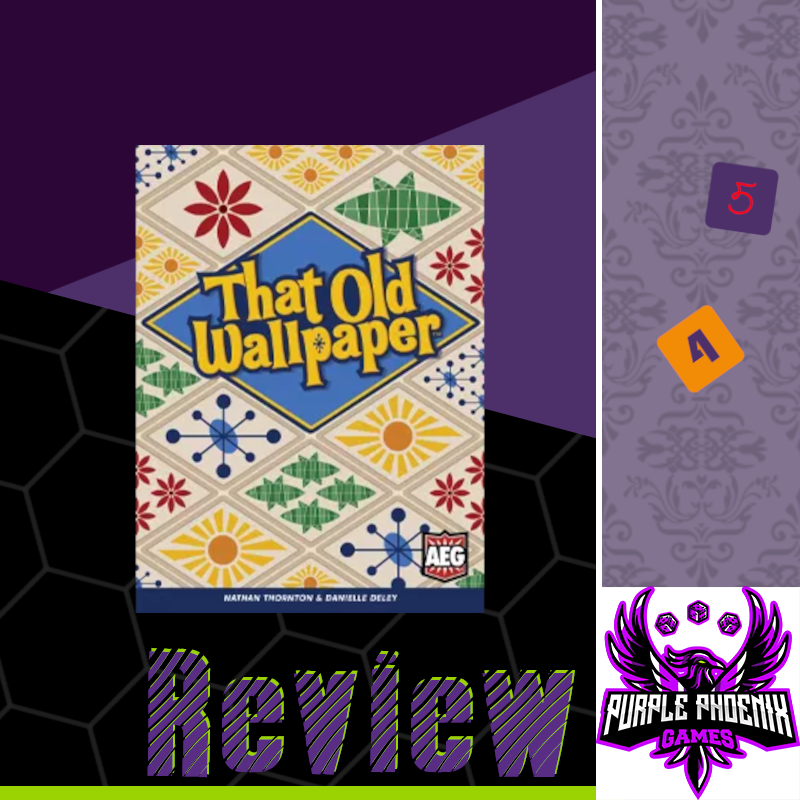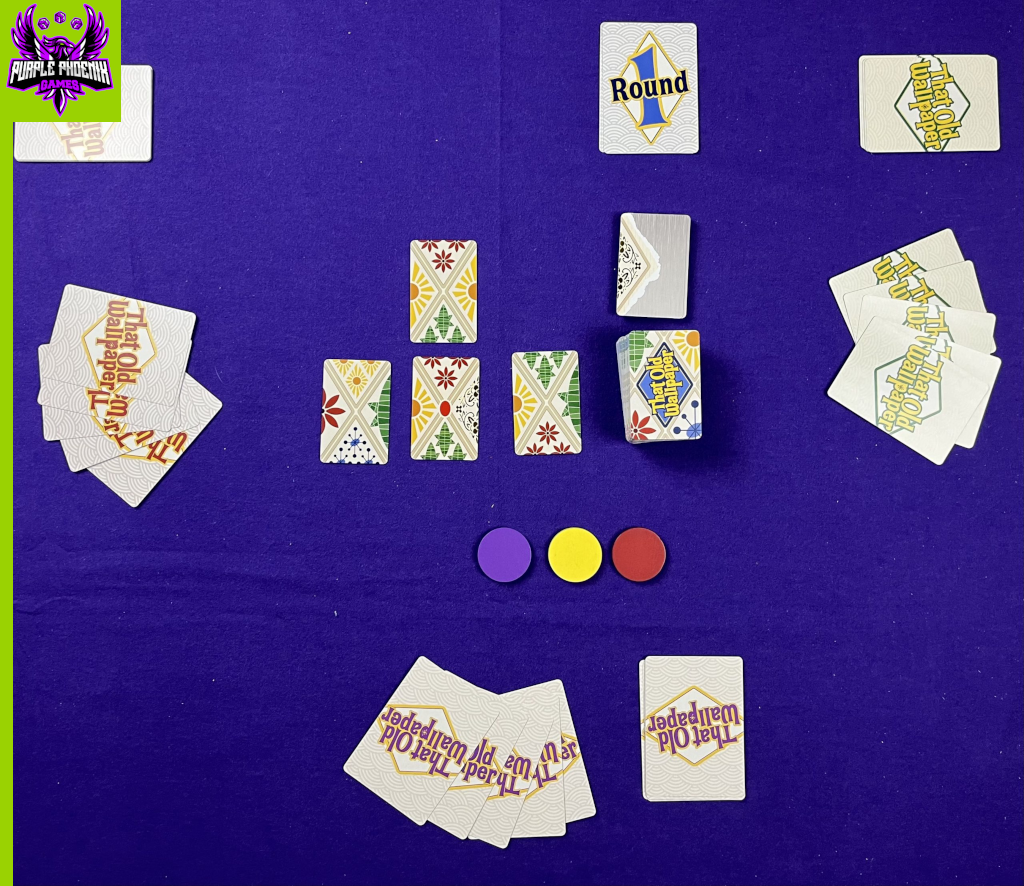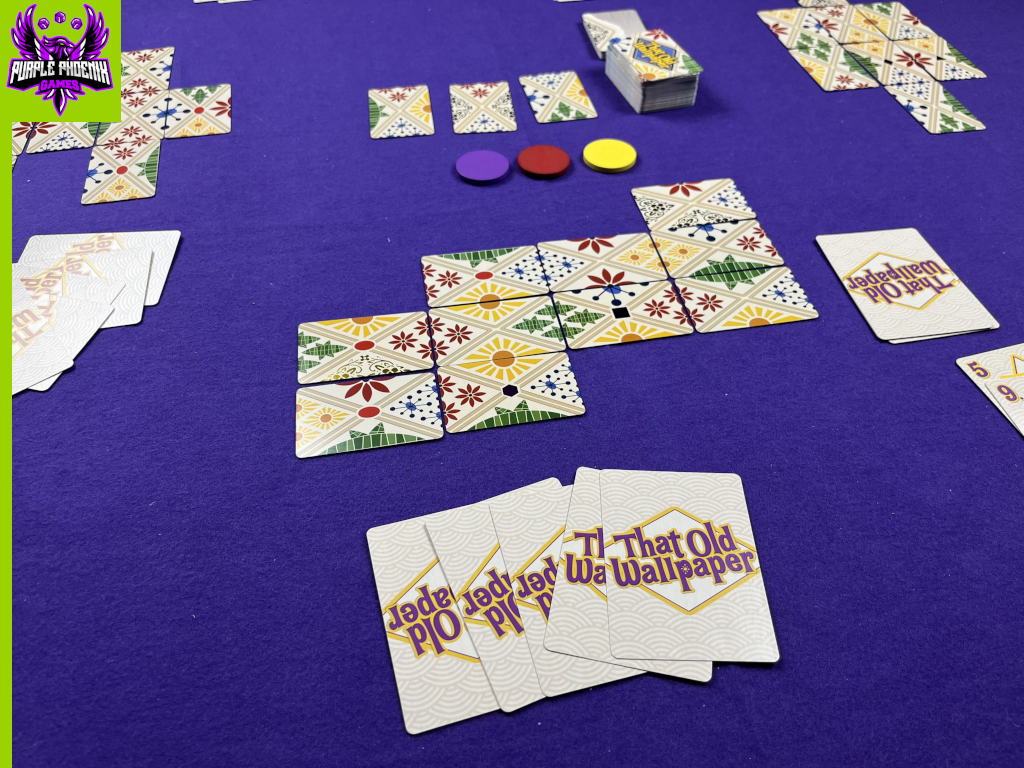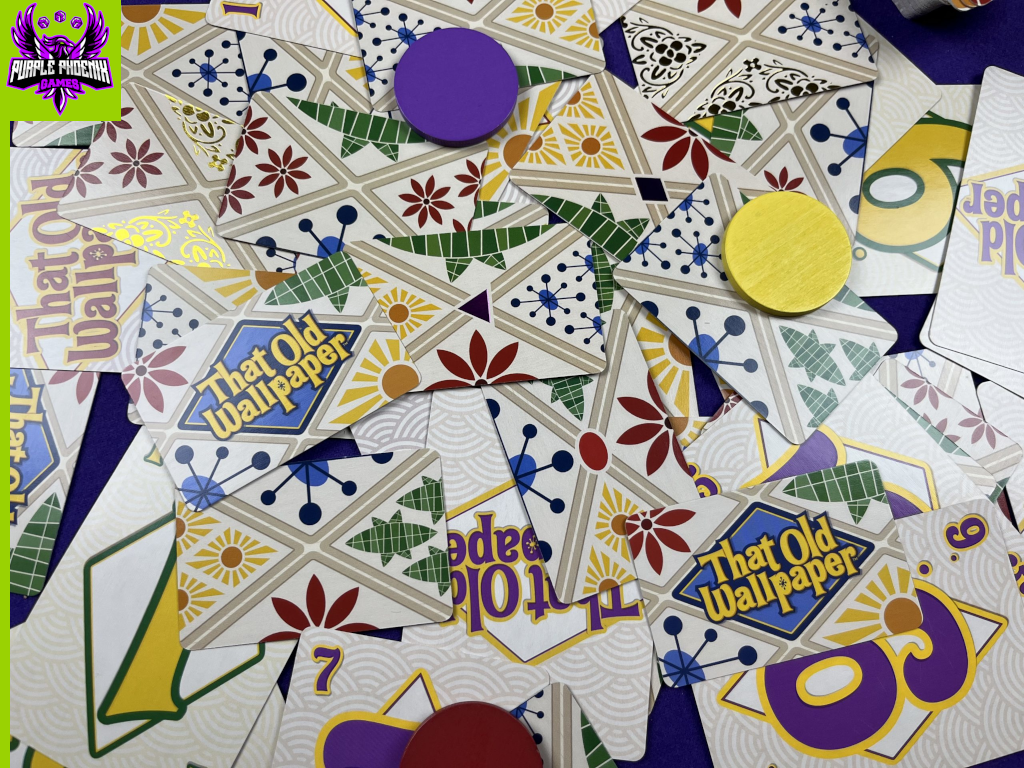
In today’s day and age, I feel like wallpaper has become pretty rare to see in new homes. But when I was a kid, it was THE thing to have. It seemed like every room had a different wallpaper, and thus, gave off a different vibe. But as times have changed, it’s become more uncommon to stumble upon those gaudy patterns from the past. Enter That Old Wallpaper – a card game that will bring you right back to those rooms with loud wallpaper that sometimes even seemed like an optical illusion.
| That Old Wallpaper (2022) | AEG |
| 2-5 players | 15-30 minutes |
| Ages 10+ | BGG Weight – 1.50 / 5 |
Disclaimer: We were provided with a copy of this game for the purposes of this review. What you see pictured below is the finalized retail version of the game. I do not intend to rehash the entire rulebook, but rather provide a general overview of the rules and gameplay. For a more in-depth look, pick up a copy from the publisher or your FLGS! -L
That Old Wallpaper is a pattern building/set collection card game in which players are attempting to recall the crazy wallpapers from their past, and recreate them to bring back the nostalgia. The game is played over a series of rounds in which players will be bidding on and drafting cards, adding them to their ‘Walls,’ and attempting to earn end-game VP for completed patterns and collections of shapes. To setup for a game, give each player a set of Bidding cards (numbered 1-10) and Perfect Recall token in their chosen color. Players shuffle those cards, and draw a starting hand of 5 Bidding cards, leaving the rest face-down in a personal draw pile. Place the Perfect Recall tokens in a line, arranged by ascending age, in the center of the play area. Shuffle the deck of Wallpaper cards to form a draw pile, and then create the face-up columns of cards available to draft for the round, as described in the rules. The column closest to the Draw pile is the “low end” and the furthest is the “high end” (more on this later). Place the Hazy Memory cards to the size, and place the Round cards to the side with Round 1 visible to all players. Select a starting player, and the game is ready to begin! Pictured below is the setup for a 3-player game.

That Old Wallpaper is played over 3 rounds in which players will be drafting Wallpaper cards to their tableau in attempts to complete patterns for end-game points. To begin the game, players will look at their hand of Bidding cards and simultaneously and secretly choose one to play this turn, placing it face-down on the table in front of them. Once all players have selected a card, all Bidding cards are revealed. The Bidding cards are now placed next to their corresponding column of Wallpaper cards, in numerical order. The lowest numbered Bidding card goes next to the column on the “low end”, the highest Bidding card on the “high end,” and any middle values are placed accordingly in ascending numerical order. In the case of a tie (multiple players play the same number Bidding card), the Perfect Recall tokens come into play. The player whose token is closest to the front of the Perfect Recall line wins the tie (collecting their chosen Wallpaper cards), and their token is now moved to the back of the line. Any player who lost the tie collects a Hazy Memory card for use at the end of the game. All players then take their corresponding Wallpaper cards and add them to their tableau, following the placement restrictions described in the rules.
After all players have placed their Wallpaper cards, everyone retrieves and discards their used Bidding card, and draws a new Bidding card to their hand. Refill the Wallpaper columns as needed, and a new turn is ready to begin. After 6 turns, the round ends. To setup for a new round, players take all of their Bidding cards and shuffle them to create a new draw deck, drawing a new hand of 5 cards. Change the Round cards to ‘Round 2’ (or ‘Final Round’) and begin the next round. At the end of the Final Round, players can place any Hazy Memory cards they acquired during the game, and then final scoring takes place.
Based on the completed patterns and various symbols on your Wallpaper cards, you will either earn or lose points at the end of the game. Players tally up their points, and the player with the highest score is the winner!

What seemed like such a simple game when I got it, turned out to be much more strategic than I could have thought. Let’s start with just the bidding element. You have to bid to claim specific columns of Wallpaper cards, but there’s no guaranteed way to ensure you get what you want. When Bidding cards are revealed, they are placed by columns in ascending numerical order. So maybe you want the cards on the ‘high end’ and play an 8 – because that’s a high value. But an opponent plays a 9 or 10 and suddenly you’re out of the cards you wanted! And since everyone shuffles their deck of Bidding cards at the start of each game/round, you kind of have no idea what number values your opponents are holding at any time! Or let’s say you’re aiming for a middle column of cards and play a 5. If all other opponents play lower cards, suddenly you’re on the ‘high end’! It’s a neat approach to the bidding mechanic, and it really makes that part of the game much more strategic than a set bidding scale.
Beyond just the bidding, the card placement rules and final scoring really start to burn your brain as you play. Ultimately, you can really place cards anywhere as long as they are orthogonally adjacent to previously played cards. But they won’t score unless they complete a pattern. And even then, you only score for completed pairs of patterns of each color, so you’re constantly trying to ensure you’ve got matching pairs on your Wall. Couple that with the bidding mechanic and you’ve got yourself quite a thinker. If you get beaten out for the cards you wanted, how can you take the cards you got stuck with and use them to your advantage? You’re constantly thinking turns in advance, trying to keep options open, while still trying to complete as many patterns as possible. Don’t let the cute theme and small cards fool you – this game will make you really think.
To touch on components briefly – this game is very well-made. As is to be expected of AEG. The cards are sturdy, the wooden tokens are chunky, and the artwork is simple but thematic. I love the addition of a score pad because when it comes to final scoring, it helps having a place to write down all of your information to figure out the correct score. Really, no complaints here about production quality. AEG has not let me down yet!
I have to admit that I was surprised by this game. I really did not expect it to be so strategic. Don’t get me wrong – you won’t spend hours agonizing over every turn in this game. It’s actually pretty light overall. But it gets you thinking more than a simple bidding game or set collection game, as the bidding mechanic is unique and you have to consider the placement of the cards you collect. It’s also really cool to see how everyone’s Wall progressed throughout the game. Starting with one or two cards, turning into an entire tableau of crazy patterns that sprawl across the table. It’s neat to watch the progress and see how people’s strategy takes form in their tableau. If you’re in the market for something relatively fast, but also decently strategic, I would recommend That Old Wallpaper. It’s definitely one that keeps me on my toes, but that won’t also take up your entire game night. Purple Phoenix Games gives this one a nostalgic 9 / 12. At least take a look at it to see if any of the Wallpaper patterns look familiar to you!

